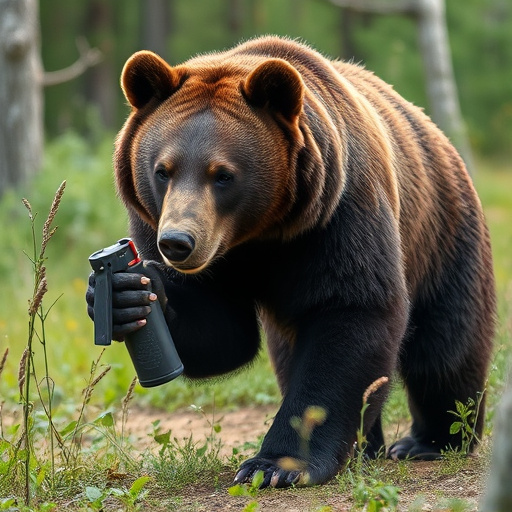Bears possess a powerful sense of smell but are usually shy. Bear spray, containing oleoresin capsicum (OC), is an effective deterrent with 2% to 8% concentrations. OC causes burning sensations and irritation in bears' eyes and respiratory system when sprayed directly in their face, enabling humans to escape or defend themselves. With strengths measured in capsaicin units (CU), 10% to 30% ppm OC spray is recommended for larger bears. Proper application techniques include aiming at the bear's face and eyes, ensuring close proximity for maximum effectiveness.
In regions where bears roam, knowing how to prevent and mitigate potential attacks is crucial. This guide delves into the effectiveness of outdoor bear attack prevention spray, focusing on the key ingredient: oleoresin capsicum (OC). Understanding OC’s role in deterring bears involves exploring their sensitivity to this capsaicin derivative and its physiological effects. We’ll also detail how to choose the right spray strength and master application techniques for maximum protection during encounters with these powerful animals.
- Understanding Bear Behavior and Their Sensitivity to Oleoresin Capsicum
- How Bear Spray Works: The Science Behind Its Effectiveness
- Choosing the Right Strength: Factors to Consider for Optimal Protection
- Application Techniques: Ensuring Maximum Impact During an Encounter
Understanding Bear Behavior and Their Sensitivity to Oleoresin Capsicum
Bears, especially black bears, are typically shy and reclusive creatures that prefer to avoid human interaction. Understanding their behavior is key to preventing potential attacks. These animals have an excellent sense of smell, which they use to detect food sources. Oleoresin capsicum (OC), the active ingredient in bear spray, takes advantage of this sensory strength. OC is a natural compound found in chili peppers that triggers a burning sensation and irritates the eyes and respiratory system.
Bear spray with a high oleoresin capsicum strength can be an effective deterrent when used correctly. The concentration typically ranges from 2% to 8%, with higher percentages offering longer-lasting protection. When sprayed directly into a bear’s face, it can temporarily blind and disorient the animal, giving humans time to retreat or defend themselves. This non-lethal method of protection is widely recommended for hikers, campers, and anyone venturing into bear country.
How Bear Spray Works: The Science Behind Its Effectiveness
Bear spray, also known as oleoresin capsicum (OC) spray, has become a popular tool for outdoor enthusiasts and those living in bear country. Its effectiveness lies in its unique active ingredient—oleoresin capsicum, a natural compound derived from chili peppers. When deployed, the spray creates a cloud of OC that is highly irritating to a bear’s eyes, nose, and respiratory system.
The strength of bear spray is typically measured in capsaicin units (CU), with higher CU indicating greater potency. Oleoresin capsicum bear spray usually ranges from 2% to 4% in concentration, ensuring it’s potent enough to deter aggressive bears while remaining safe for human use. This powerful irritant causes the bear to experience a temporary yet intense sensation of pain, leading to a quick retreat. The science behind its effectiveness has been well-documented, making bear spray a reliable and game-changing tool for personal safety in bear habitats.
Choosing the Right Strength: Factors to Consider for Optimal Protection
When selecting an outdoor bear attack prevention spray, understanding the oleoresin capsicum (OC) bear spray strength is paramount. OC bear spray temporarily blinds and disorients bears, providing crucial time to escape. The effectiveness of this defense depends on the concentration of capsaicin, the active ingredient in OC spray. Strength is measured in percent or parts per million (ppm). Higher concentrations like 10% to 30% ppm offer superior protection against larger bears, such as grizzly and black bears.
Several factors influence the choice of bear spray strength. The type of bear encounters you’re most likely to face plays a significant role. In areas known for aggressive or unpredictable bear behavior, opt for stronger concentrations. Terrain and weather conditions can also affect performance; wind and moisture may reduce spray range and effectiveness, necessitating a higher-strength option. Always read product labels and follow manufacturer recommendations for optimal protection during your outdoor adventures in bear country.
Application Techniques: Ensuring Maximum Impact During an Encounter
When using outdoor bear attack prevention spray, proper application techniques are crucial for maximizing its impact during an encounter. The key lies in aiming directly at the bear’s face and eyes, as these areas contain a high concentration of sensitive nerves. Spraying from a distance allows the wind to carry the oleoresin capsicum (OC) bear spray towards the bear, but it may not be effective enough. Getting up close and personal, while daunting, ensures that the OC spray makes contact with the bear’s eyes and nostrils, causing temporary blindness, coughing, and irritation, which can create a safe escape route.
Understanding the strength of your bear spray is essential. High-quality OC bear spray should contain at least 1% capsaicin, delivering a powerful punch to deter aggressive bears. The can’s nozzle design also matters; a narrow stream allows for precise targeting, enabling you to cover more distance with each spray without wasting valuable moments in an encounter. Practice makes perfect; regular training sessions will help you master the application techniques and ensure your safety in the great outdoors.
Bear attacks can be rare, but preparedness is key. Outdoor enthusiasts should invest in high-quality oleoresin capsicum bear spray, choosing a strength that matches the potential threats they face. Understanding how this spray works and mastering application techniques can significantly enhance safety during encounters with bears. By following the guidelines outlined in this article, individuals can better protect themselves and minimize the risk of dangerous bear interactions while enjoying the outdoors.
